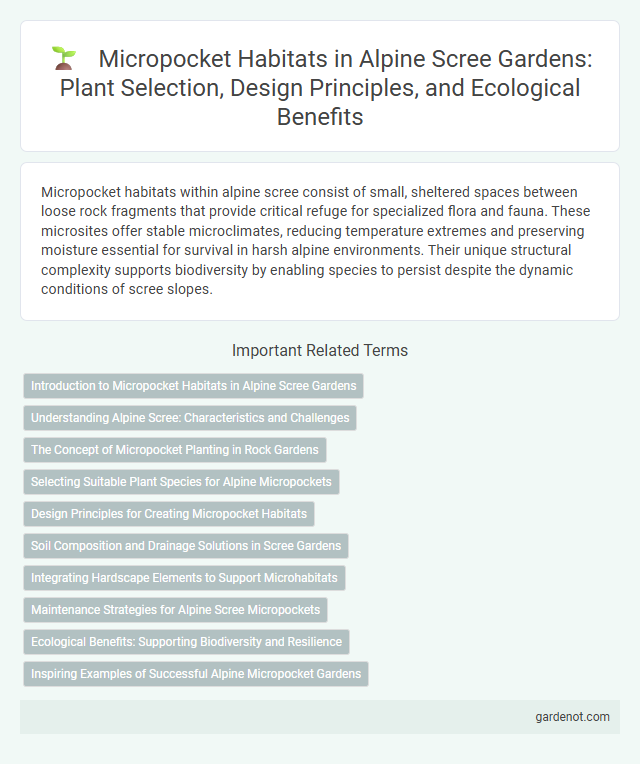Micropocket habitats within alpine scree consist of small, sheltered spaces between loose rock fragments that provide critical refuge for specialized flora and fauna. These microsites offer stable microclimates, reducing temperature extremes and preserving moisture essential for survival in harsh alpine environments. Their unique structural complexity supports biodiversity by enabling species to persist despite the dynamic conditions of scree slopes.
Introduction to Micropocket Habitats in Alpine Scree Gardens
Micropocket habitats in alpine scree gardens consist of small crevices and cavities formed by loose rock fragments that provide microclimates essential for specialized flora and fauna. These niches offer protection from harsh winds and temperature extremes, facilitating the growth of moisture-retentive mosses, lichens, and cold-adapted invertebrates. Understanding micropocket dynamics is crucial for conserving biodiversity within alpine scree ecosystems.
Understanding Alpine Scree: Characteristics and Challenges
Micropocket habitats in Alpine scree areas offer unique microenvironments characterized by loose, fragmented rock debris that provides shelter and moisture retention essential for specialized flora and fauna. These habitats face challenges such as extreme temperature fluctuations, limited nutrient availability, and susceptibility to erosion. Understanding the physical structure and microclimatic conditions of Alpine scree is crucial for conserving its biodiversity and managing fragile ecosystems effectively.
The Concept of Micropocket Planting in Rock Gardens
Micropocket planting in rock gardens leverages small, protected niches within alpine scree to cultivate specialized plant species that thrive in minimal soil and harsh conditions. These microhabitats create optimal moisture retention and shelter from extreme weather, enabling delicate alpine flora to establish roots and flourish. Incorporating micropockets into rock garden design enhances biodiversity by mimicking natural alpine scree ecosystems and supporting rare or slow-growing species.
Selecting Suitable Plant Species for Alpine Micropockets
Selecting suitable plant species for Alpine micropockets requires prioritizing hardy, low-growing alpine flora adapted to extreme temperature fluctuations and shallow, well-drained soils typical of scree environments. Species such as Saxifraga oppositifolia, Silene acaulis, and Androsace alpina exhibit tolerance to desiccation and rapid drainage, ensuring successful establishment within microhabitats. Incorporating native cushion plants enhances soil stabilization and moisture retention, critical for sustaining the delicate balance of alpine micropocket ecosystems.
Design Principles for Creating Micropocket Habitats
Design principles for creating micropocket habitats in alpine scree emphasize replicating natural rock crevices with varied sizes and orientations to offer shelter and microclimate stability for specialized flora and fauna. Incorporating native substrate materials and ensuring moisture retention while facilitating drainage enhances habitat suitability and biodiversity. Strategic placement that mimics natural shadow patterns and wind exposure supports temperature regulation critical for the survival of alpine scree specialists.
Soil Composition and Drainage Solutions in Scree Gardens
Micropocket habitats in alpine scree rely heavily on well-drained, coarse soil composed mainly of gravel, sand, and fragmented rock particles that mimic natural scree conditions. Effective drainage solutions in scree gardens incorporate porous substrates and strategic layering with larger stones to prevent waterlogging while facilitating rapid runoff. These soil composition and drainage strategies are crucial for supporting specialized flora adapted to nutrient-poor, aerated environments typical of alpine scree ecosystems.
Integrating Hardscape Elements to Support Microhabitats
In Alpine scree environments, integrating hardscape elements such as angular rocks and boulders creates essential microhabitats for micropocket species, providing shelter and moisture retention. These structures promote biodiversity by stabilizing temperature fluctuations and offering protection from wind and predators. Effective placement and layering of hardscape maximize habitat complexity, supporting specialized flora and fauna adapted to harsh, rocky conditions.
Maintenance Strategies for Alpine Scree Micropockets
Maintaining alpine scree micropockets involves regular monitoring of temperature fluctuations and moisture levels to preserve microhabitat stability crucial for endemic species. Strategic removal of invasive vegetation and controlled soil disturbance promote native plant regeneration while preventing erosion. Implementing adaptive management techniques based on long-term ecological data ensures resilience against climate variability in these fragile habitats.
Ecological Benefits: Supporting Biodiversity and Resilience
Micropockets within alpine scree provide crucial microhabitats that support specialized flora and fauna, enhancing local biodiversity by offering refuge from extreme conditions. These habitat niches contribute to ecological resilience by enabling species to survive environmental stressors such as temperature fluctuations and erosion. Preservation of micropocket habitats is essential for maintaining ecosystem stability and promoting adaptive capacity in alpine environments.
Inspiring Examples of Successful Alpine Micropocket Gardens
Alpine micropocket gardens exemplify highly effective use of small, sheltered microhabitats within scree environments, supporting diverse plant species adapted to harsh conditions. Successful designs utilize rock placements to create thermal stability and moisture retention, promoting growth of endemic alpine flora like Saxifraga and Androsace. These inspiring examples demonstrate how precise microclimate control in tiny niches leads to thriving, resilient alpine ecosystems.
Micropocket habitat Infographic

 gardenot.com
gardenot.com